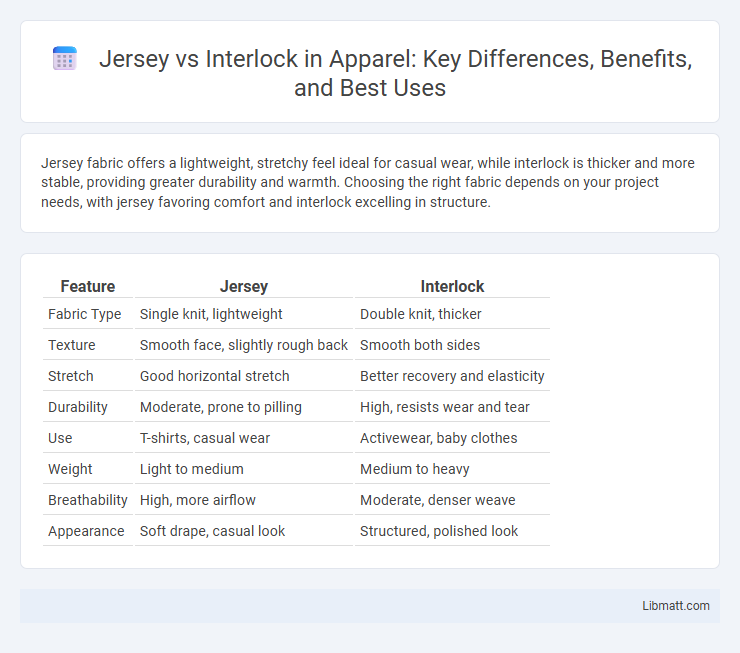Jersey fabric offers a lightweight, stretchy feel ideal for casual wear, while interlock is thicker and more stable, providing greater durability and warmth. Choosing the right fabric depends on your project needs, with jersey favoring comfort and interlock excelling in structure.
Table of Comparison
| Feature | Jersey | Interlock |
|---|---|---|
| Fabric Type | Single knit, lightweight | Double knit, thicker |
| Texture | Smooth face, slightly rough back | Smooth both sides |
| Stretch | Good horizontal stretch | Better recovery and elasticity |
| Durability | Moderate, prone to pilling | High, resists wear and tear |
| Use | T-shirts, casual wear | Activewear, baby clothes |
| Weight | Light to medium | Medium to heavy |
| Breathability | High, more airflow | Moderate, denser weave |
| Appearance | Soft drape, casual look | Structured, polished look |
Introduction to Jersey and Interlock Fabrics
Jersey fabric is a single-knit textile known for its stretchiness, softness, and breathability, commonly used in casual wear and t-shirts. Interlock fabric, a double-knit textile, offers a thicker, more stable structure with a smooth surface and higher durability, making it ideal for activewear and baby clothing. Understanding the differences in weight, texture, and stretch between jersey and interlock helps you select the best fabric for your specific garment needs.
Key Differences Between Jersey and Interlock
Jersey fabric is a single-knit textile known for its stretchiness, lightweight feel, and slight curl at the edges, making it ideal for t-shirts and casual wear. Interlock is a double-knit fabric with a thicker, smoother surface and more stability, offering less stretch but enhanced durability and softness that works well for activewear and baby clothing. Understanding the key differences between jersey and interlock helps you choose the right fabric based on your desired comfort, structure, and garment use.
Fabric Composition and Structure
Jersey fabric is typically made from single-knit construction using cotton, polyester, or blends, featuring a smooth, stretchy surface with visible vertical ribs on the back. Interlock fabric consists of two layers of jersey knit intermeshed together, creating a thicker, denser, and more stable fabric with a smooth finish on both sides. The interlock knit structure increases durability and provides better insulation compared to the lighter, more breathable jersey fabric.
Softness and Texture Comparison
Jersey fabric is known for its soft, smooth texture with a slight stretch, providing a comfortable and breathable feel ideal for casual wear and lightweight garments. Interlock fabric offers a thicker, denser knit with a plush, smooth surface on both sides, resulting in enhanced softness and a slightly heavier weight compared to jersey. The double-knit structure of interlock gives it a more substantial texture, making it well-suited for products requiring durability and a luxurious hand feel.
Stretch and Flexibility: Jersey vs Interlock
Jersey fabric offers exceptional stretch and flexibility due to its single-knit construction, making it ideal for activewear and garments requiring ease of movement. Interlock fabric, with its double-knit structure, provides moderate stretch but superior stability and shape retention compared to jersey. Both fabrics feature natural elasticity, but jersey's greater extensibility suits designs prioritizing comfort and flexibility.
Durability and Longevity
Jersey fabric offers moderate durability suitable for everyday wear, with its single-knit structure providing softness but limited resistance to heavy abrasion over time. Interlock fabric features a double-knit construction, significantly enhancing its strength and longevity, making it more resistant to stretching, pilling, and wear from frequent washing. Choosing interlock for Your garments ensures better long-term performance and maintains a smooth, resilient texture even after extensive use.
Breathability and Comfort Factors
Jersey fabric offers excellent breathability due to its lightweight, porous knit structure, making it ideal for warm climates and activewear that require moisture-wicking properties. Interlock fabric, with its denser double-knit construction, provides superior comfort through added softness and durability while maintaining moderate breathability and better insulation. Choosing between the two depends on your specific needs for ventilation and cushioning in daily wear or athletic apparel.
Common Uses in Fashion and Apparel
Jersey fabric is widely used in casual wear, including t-shirts, dresses, and activewear, due to its lightweight, stretchy, and breathable properties. Interlock fabric is favored for baby clothes, loungewear, and high-quality sportswear, offering a thicker, more stable texture with excellent durability and softness. Both fabrics are popular in fashion for their comfort and versatility but cater to different garment needs based on weight and structure.
Care and Maintenance Tips
Jersey fabric requires gentle washing in cold water and air drying to maintain its softness and prevent shrinkage, while interlock fabric benefits from similar care but is slightly more durable with less pilling. Avoid high heat when ironing jersey to preserve its shape, whereas interlock can handle low to medium heat due to its denser knit structure. Both fabrics perform best when washed inside out and with mild detergents to extend their lifespan and retain color vibrancy.
Choosing the Right Fabric: Jersey or Interlock?
Jersey fabric offers a lightweight, stretchy texture ideal for breathable casual wear, while Interlock provides a thicker, more durable knit that maintains its shape better over time. Your choice depends on whether you prioritize softness and flexibility with Jersey or the sturdiness and smooth finish of Interlock for long-lasting garments. Consider the garment's purpose and desired feel to select the fabric that best complements your project's needs.
jersey vs interlock Infographic

 libmatt.com
libmatt.com